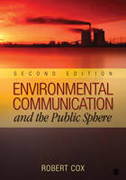
Environmental Communication and the Public Sphere" is the first comprehensiveundergraduate textbook in the growing field of environmental communication. It takes as its theme the role of communication in influencing the ways in which we perceive the environment as well as what actions we and others take in our relations to the natural world. The text blends scholarship and hands-on experiences to provide a theory-based and coherent description of the concrete communication practices and sites in the debates over environment protection. Additional theory and vocabulary are introduced, as are case studies and examples for closer examination of the principal sites and practices of environmentalcommunication - including forums for public participation, advocacy campaigns, media coverage of environmental stories, risk communication, and models of dispute settlement. This accessible book: summarizes current scholarship in thearea and makes accessible many of the practices of media, corporations, and advocacy groups that are not readily available in public sources; gives students insight into the practical ways to participate publicly in influencing the decisions of governmental agencies that affect the environment; offers a comprehensible treatment of the complexity and range of issues, sites, and practicesin environmental communication; and, includes 'Act Locally' exercises, which provide opportunities for students to apply their knowledge of the principles of environmental communication. INDICE: PART I: CONCEPTUAL PERSPECTIVES 1. Studying Environmental Communication The Field of Environmental Communication Nature, Communication, and the Public Sphere Diverse Voices and Interests in a "Green" Public Sphere 2. Social/Symbolic Constructions of "Environment" The U.S. Environmental Movement Social/Symbolic Approaches to the Environment Visual Rhetorics: Portraying Nature PART II. CITIZEN VOICES AND PUBLIC FORUMS 3. Public Participation in Environmental Decisions Right to Know: Access to Information Right of Public Comment Right of Standing in Court: Citizen Suites Citizens' Communication and Public Participation Growth of Public Participation Internationally 4. Conflict Resolution and Collaboration in Environmental Disputes New Approaches to Environmental Disputes Collaborating to Resolve Environmental Conflicts Limits of Collaboration and Consensus PART III. MEDIA COVERAGE OF THE ENVIRONMENT 5. Media and the Environment Online Media Depictions of Nature News Production and the Environment New Media and the Environment Online Media Effects 6. Risk Communication: Environmental Dangers and the Public Dangerous Environments: Assessing RiskCommunicating Environmental Risks to the Public Media and Environmental Risk PART IV. VOICES FOR CHANGE 7. Environmental Advocacy Campaigns Environmental Advocacy Environmental Advocacy Campaigns The Campaign to Protect Zuni Salt Lake The Attitude-Behavior Gap and the Challenges of Advocacy 8. Environmental Justice/Climate Justice: Voices From the Grassroots Whose Environment? Whose Voices? Building the Movement for Environmental Justice Indecorous Voices and Democratic Inclusion The Global Movement for Climate Justice PART V. ENVIRONMENTAL DISCOURSES OF SCIENCE AND INDUSTRY 9. Science Communication and Environmental Controversies Science and Symbolic Legitimacy Boundaries The Precautionary Principle Science and Symbolic Legitimacy Conflict Early Warners: Disputes Overthe Public Role of Environmental Scientists 10. Green Marketing and CorporateAdvocacy Free Market Discourse and the Environment Corporate Green Marketing Corporate Advocacy: Three Bites of the Apple SLAPP Lawsuits: Strategic Litigation Against Public Participation Epilogue: Imagining a Different WorldAuthor Biography: Robert Cox (Ph.D., University of Pittsburgh) is Professor of Communication Studies and the Curriculum Ecology at the University of North Carolina at Chapel Hill. His principal research and teaching areas are environmental communication, rhetorical theory, and critical study of the discourse of social movements. Considered one of the nation's leading scholars in environmental communication, he has been President of the Sierra Club three times (2007-2008, 2000--2001 and 1994--1996) and has served on the Sierra Club's Board of Directors for 14 years. His published work includes critical studies of thediscourse of civil rights, peace movement, labor, and the environmental movement. Cox currently serves as a Board member of Environmental Communication: A Journal of Nature and Culture, and previously served as Associate Editor for the Quarterly Journal of Speech. In addition to his teaching activities, Cox advises environmental groups and is called upon regularly to participate in numerous initiatives concerning the environment. In 2000, he campaigned with former Vice President Al Gore and singer Melissa Etheridge in the U.S. presidentialelection.
- ISBN: 978-1-4129-7211-6
- Editorial: Sage
- Encuadernacion: Rústica
- Páginas: 383
- Fecha Publicación: 15/09/2009
- Nº Volúmenes: 1
- Idioma: Inglés
